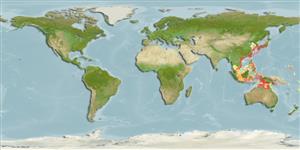>
Eupercaria/misc (Various families in series Eupercaria) >
Labridae (Wrasses) > Bodianinae
Etymology: Choerodon: Greek, choiros = a pig + odous = teeth (Ref. 45335); referrring to the prominent anterior canines of the species in this genus (Ref. 116605).
More on authors: Jordan & Snyder.
Environment: milieu / climate zone / depth range / distribution range
Ecología
marino asociado a arrecife, usually 8 - 50 m (Ref. 27115). Subtropical; 23°C - 28°C (Ref. 27115)
Western Pacific: southern Japan, Korean Peninsula, Taiwan, and the China seas.
Tamaño / Peso / Age
Maturity: Lm ? range ? - ? cm
Max length : 40.0 cm TL macho / no sexado; (Ref. 90102)
Espinas dorsales (total): 13; Radios blandos dorsales (total): 7; Espinas anales 3; Radios blandos anales: 10. Body anterior to wedge in adults somewhat dusky, paler posteriorly. Body with an anteroventrally angled narrow dusky wedge extending from base of tenth or eleventh dorsal-fin spine to posterior side of pectoral-fin base. Scales on subopercle reaching to or nearly to below anterior extent of ventral preopercular edge; predorsal scales reaching nearly to above posterior extent of orbit on dorsal midline of head (somewhat short of this in very large specimens). Juveniles somewhat mottled, but with a faint indication of above pattern and an ocellated dark spot posteriorly on dorsal fin.
Adults are found near shore in rock bottom (Ref. 11230). Oviparous, distinct pairing during breeding (Ref. 205). In Hong Kong live fish markets (Ref. 27253).
Life cycle and mating behavior
Madurez | Reproducción | Puesta | Huevos | Fecundidad | Larva
Pelagic spawner. Oviparous, distinct pairing during breeding (Ref. 205).
Masuda, H., K. Amaoka, C. Araga, T. Uyeno and T. Yoshino, 1984. The fishes of the Japanese Archipelago. Vol. 1. Tokai University Press, Tokyo, Japan. 437 p. (text). (Ref. 559)
IUCN Red List Status (Ref. 130435)
Threat to humans
Harmless
Human uses
Acuario: Comercial
Más información
ReferenciasAcuiculturaPerfil de acuiculturaRazasGenéticaElectrophoresesheritabilidadEnfermedadesProcesamientoNutrientsMass conversion
ColaboradoresImágenesStamps, Coins Misc.SonidosCiguateraVelocidadTipo de nataciónSuperficie branquialOtolitosCerebrosVisión
Herramientas
Special reports
Download XML
Fuentes de Internet
Estimates based on models
Preferred temperature (Ref.
123201): 20.4 - 28.9, mean 27.7 °C (based on 718 cells).
Phylogenetic diversity index (Ref.
82804): PD
50 = 0.5000 [Uniqueness, from 0.5 = low to 2.0 = high].
Bayesian length-weight: a=0.01698 (0.00689 - 0.04188), b=3.03 (2.81 - 3.25), in cm total length, based on LWR estimates for this (Sub)family-body shape (Ref.
93245).
Nivel trófico (Ref.
69278): 3.5 ±0.37 se; based on food items.
Resiliencia (Ref.
120179): Medio, población duplicada en un tiempo mínimo de 1.4-4.4 años (Preliminary K or Fecundity.).
Fishing Vulnerability (Ref.
59153): Low to moderate vulnerability (30 of 100).
Nutrients (Ref.
124155): Calcium = 27.3 [12.6, 57.3] mg/100g; Iron = 0.529 [0.281, 1.108] mg/100g; Protein = 18.9 [16.0, 21.2] %; Omega3 = 0.164 [0.090, 0.293] g/100g; Selenium = 16.2 [7.4, 33.1] μg/100g; VitaminA = 40 [10, 217] μg/100g; Zinc = 0.739 [0.465, 1.309] mg/100g (wet weight);
